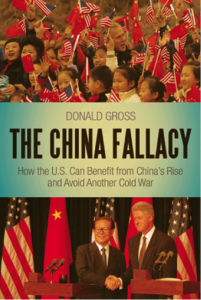 Review by Stanton Jue
Review by Stanton Jue
The China Fallacy: How the U.S. Can Benefit From China’s Rise and Avoid Another Cold War by Donald Gross, Bloomsbury, New York & London, 2012, ISBN-13:978-1441147899, paperback 2013, 320 pp., $117 hardcover, $29.95 paperback, $10.95 Kindle edition.
On February 21, 1972, President Richard Nixon arrived in Beijing on a historic visit, a visit that dramatically altered the global strategic order by transforming China from an adversary in wars and hostilities to one of rapprochement and hopeful collaboration. This policy shift was an experiment in which both countries approached it without illusion or knowing whether it would work or not. At an initial encounter, a welcome banquet, President Nixon uttered these words to Chinese premier Zhou Enlai:
The Chinese people are a great people, the American people are a great people. If our two peoples are enemies, the future in this world we share together is dark indeed. But if we can find common ground to work together, the chance for world peace is immeasurably increased … So let us start a long march together, not in lock steps, but on different roads leading to the same goal of building a world structure of peace and justice….
U.S. Embassy in Beijing, February 21, 1972
The principles underpinning this new approach to US-China relations have been pursued by the U.S. government in the past 40 plus years, with ups and downs caused by mistaken bombing of the Chinese Embassy in Belgrade in May 1999 and the downing of EP-3 reconnaissance plane in South China Sea in April 2001, not to mention the unforgettable massacre of students at Tiananmen Square in June 1989. But the central thrust of U.S. policy toward China has been engagement, not confrontation.
However, since the 1980s, China’s dramatic economic growth along with massive military expansion has created new fear that the rise of China may not be peaceful but a threat to American prosperity at home and power abroad. China hawks and protectionists in the U.S. warned us that China’s need to access western technology and world markets will inevitably lead to confrontation with the West, especially the U.S. At the same time, a large number of books and media commentaries have come out on the rise of China and what it means to the U.S. as the sole world superpower. Is China a threat or a peaceful collaborator? This debate continues to increase the separation of books and writers into two broad camps — confrontation and engagement.
Gross’s book, nearly 300-page long, well written and easy to understand, clearly falls within the confines of the engagement camp. A former State Department and White House official, he has a good understanding of foreign policy making and the implications of short term and long term impacts, and linkages to domestic challenges of both countries. He argues forcefully that U. S. policy is largely driven by fear — fear of a possible military confrontation with China and fear of competition with an economic juggernaut that will harm American prosperity. In his book, he urges the U.S. government to find new ways to deal with China. He also explains in detail how the U.S. can benefit from China’s rise and avoid another war.
On the confrontation camp, China hawks and protectionists, though a vocal minority, regularly and persistently warned the government to develop a new strategy to contain China’s aggressive expansion. Yet some of these critics seemed to ignore the fact that the United States is not a static power doing nothing to protect the American people. Moreover, the United States has many special strengths such as openness and innovation, research and development, higher education and entrepreneurial expertise which will keep the country competitive and strong. Gross believes China is an emerging superpower while the U.S. is losing its sole world superpower status. China, India and possibly other countries will move up closer to superpower ranks, but the U.S. will remain first among the great powers.
A New Paradigm
Facing this new reality, Gross advocates a new paradigm for U.S. China relations. In Chapter 7, he recommends a fundamental shift of policy and commitment by both countries to build a foundation for peaceful coexistence and greater cooperation. To do it right, he calls for a new framework agreement embracing a wide range of strategic, economic, and political measures. Essentially, a framework agreement is a declaration of principles and goals agreed on by both sides. It is expected that, when mutual confidence gradually increases, the agreed goals can be realized in stages over time through step-by-step negotiations. A bit overly optimistic, but because of suspicion and mistrust, both nations still have a ways to go to reach unity of purpose.When the U.S. announced planned drawdown of military operations in the Middle East in 2011, it was described by many as a pivot of U.S. presence to maintain a balance of forces for peace and stability in the region in East Asia. However, the Chinese reacted to this as a U.S. attempt to contain Chinese legitimate ambition to gain access to natural resources for peaceful development.
Meantime, the goal of the new paradigm for peaceful engagement and cooperation is similar to what the U.S. and China have tried to develop in recent years. Since 2009 Washington and Beijing have agreed to institutionalize a series of Strategic and Economic Dialogue (S&ED) to address ongoing disputes and problems, held alternately at each other’s capital, to build a paradigm for a cooperative strategic, economic and political relationship.
Look at the 5th SED held in Washington this past July, this super cabinet level meeting produced an impressive list of 91 outcomes while indicating areas that require further joint action.* This is truly a remarkable achievement since Nixon’s 1972 visit, which initiated a plan for engagement and cooperation — reflecting the letter and spirit of the joint declaration to “find common ground to work together, not in lock steps, but in different roads leading to the same goal, the goal of building a world structure of peace and justice …”
Of course, some of the strategic disputes and problems remain controversial and difficult to reach a consensus, such as cyber security, military-to-military contact, trade and investment, human rights and democracy. As an illustration, the recent annual human rights dialogue held in China reveals China’s human rights record as worsening and that both sides simply agreed to disagree. However, a glimmer of hopes flickers. Both countries agreed to set up a series of “working groups” within the SED platform to work toward a solution, not to ignore them. As laudable as these efforts are, both the United States and China still do not trust each other completely. Critics described the present management of the bilateral relationship as that of a couple sharing the same bed but not dreaming the same dream.
In my view, The China Fallacy by Don Gross is a valuable contribution to the debate on the broad implications of a rising China. In this violent world, we cannot afford not to find common ground to work with China an emerging superpower for the simple reason that we do not want nor can we afford another catastrophic war.![]()
Notes*
Office of the Spokesperson, U. S. State Department, US-China Strategic and Economic Dialogue Outcomes of the Strategic Track, 7/12/13.
** See Washington Post, A-7, August 3, 2013.
American Diplomacy is the Publication of Origin for this work. Permission to republish is freely granted with credit and a link back to American Diplomacy

